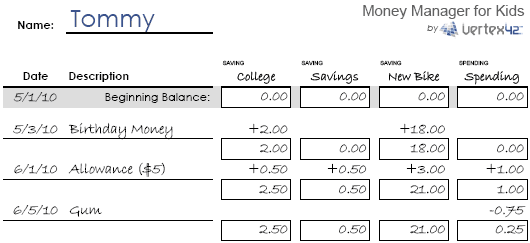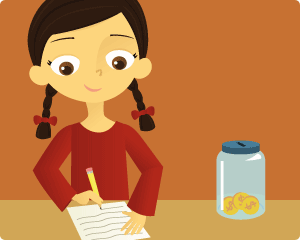If you have kids, you've probably tried various methods to help your younger kids save and manage their money. We started out using the envelope method, but that wasn't working for us.
The problem with the envelope method was that we never had the cash or change on hand to put into the envelopes. Also, the kids were losing the money, misplacing it, or sometimes giving it away (sometimes because they were being manipulated by older children).
At a recent family reunion, we were discussing this problem and someone told us about a system that was working well for them: the Family Bank approach. Here's how it works ...
Setting Up the Family Bank
1. Print a copy of the Money Manager for Kids worksheet for each child.
I created a free printable worksheet that lets you keep track of both savings and spending money, just like you would do with the envelope method. Visit this page to download the worksheets.
You may also want to print out the example worksheet to help explain the process to your kids. (click on the image to the right)
2. At the top of each column, enter a name for each savings or spending account.
We use Tithing (charity), College (long-term savings), Savings (short-term savings), and Spending. If you have used the envelope method in the past, think of each column as a separate envelope. Teach your children why it is important to keep the spending money separate from the savings. One of the savings accounts can be for long-term savings, and the other can be used for short-term savings (like saving for a new bike).
3. Get a jar or container to use for the "Family Bank"
You're going to need to keep some cash and change in the family bank to handle the times when your kids need to have cash to pay for stuff at school, buy gum, or whatever. Keep the money in a safe/secret place.
If you pay allowances, you won't actually need to exchange any physical money. You can just record the allowance as a deposit. However, just like real bank owners, you should make sure that you have enough money (either in the Family Bank or in your checking account) to pay your children if they need to make a withdrawal.
4. Make the initial deposits
Have each child round up all their money and then deposit the money into the family bank. They can put the money into the bank, but you should help them record the starting balances in the appropriate columns.
If a child doesn't want to put all their spending money into the bank, remind them that the money is still theirs - it's just going to be kept in a safe place so they don't lose it (show them the jar). Remind them that when they need it, they can just withdraw it from the family bank (with the help of a parent).
It they still don't want to put their spending money into the bank, think about the movie Mary Poppins ... don't push the issue. Just remind them that it's their responsibility to keep track of their spending money if they don't want to put it into the bank for safe keeping.
5. Tape the worksheets to the inside of a cupboard or pantry door
The kids need to know that they can check how much money they have at any time, by looking at their "bank statement". BUT, you should also make a rule that only a parent can write on the worksheet. You also might make a rule that older children can only write on the worksheet under the guidance of a parent.
Example

Example showing how to use the Money Manager for Kids worksheet.
Share Your Experiences
We've been using this approach for a few months now and it's working well. There is much less confusion, fewer tears over lost coins, and the kids actually seem to enjoy it.
If you decide to use these worksheets, or have done something similar, please share your experiences by commenting below.
Enjoy,
Jon W.





Comments
wonderful…….
Yeah its just great and I use an online allowance tool at threejars which is somewhat similar to Family bank approach!!
This is a fantastic tool to teach the kids about money. Plus, unlike threejars, this one is FREE!
Love this! Thank you for sharing!